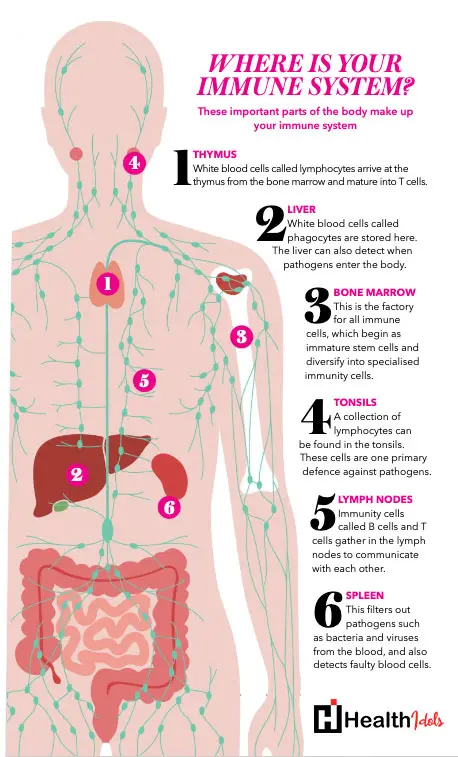Your immune system is an incredible biological defense force, working around the clock to protect you from harmful invaders like bacteria and viruses. Our understanding of this complex system began in the late 19th century, thanks to pioneering scientists who discovered key players like phagocytes (cells that engulf pathogens) and antibodies (proteins that neutralize threats).
Even before birth, your immune defenses are bolstered by passive immunity passed from your mother through the placenta and breastmilk. This temporary protection helps guard against specific pathogens your mother has encountered.
As you navigate the world, your immune system continues to build a robust arsenal of defenses through active immunity. The first line of this defense is the innate immune system, with physical barriers like skin, mucus, and stomach acid providing formidable fortifications against invaders.
Should a pathogen breach these outer defenses, internal forces like white blood cells swing into action. Phagocytes, such as neutrophils and macrophages, literally devour intruders. Mast cells release histamine to trigger inflammation, while fever-inducing pyrogens provide a metabolic boost to immune cells and create an inhospitable environment for pathogens.
If these innate responses can’t quell the threat, the adaptive immune system mobilizes. Here, lymphocytes (another type of white blood cell) use antigens (pathogen identifiers) and antibodies (pathogen mugshots) to precisely target and eliminate invaders. Memories of past battles allow the immune system to mount faster, stronger responses to repeat offenders.
In cases where the immune system requires reinforcements, antibiotics can help eradicate bacterial infections, while antiviral medications limit the spread of certain viruses. Vaccines exploit the adaptive immune system’s memory, safely exposing it to harmless antigens to prime it against future attacks from specific pathogens.
From its multi-layered defenses to its incredible adaptability, the immune system is a remarkable biological security force. Understanding its intricate workings not only reveals the marvels of our bodies but also guides treatments and preventive measures that enhance our resilience against disease.
The Immune System’s Specialized Forces

While the immune system operates as an integrated defense network, it comprises several specialized cell types, each with unique roles in identifying, combating, and coordinating the response against threats.
Basophils are a type of white blood cell known as granulocytes. When an infection strikes, basophils quickly release histamines and heparin, chemicals that amplify the inflammatory response and recruit additional immune reinforcements to the site of attack.
If pathogens manage to evade initial defenses, the immune system calls upon its elite assassins: natural killer (NK) cells. True to their name, these cells actively hunt down and terminate infected or cancerous cells with precise lethal force.
Neutrophils are typically the first responders when a pathogen breaches the body’s barriers. These white blood cells rapidly engulf invaders and employ potent enzymes to destroy them from within.
Macrophages, meaning “big eaters,” are large phagocytic cells that can devour pathogens, as well as scavenge and recycle the remains of cells killed during immune battles.
Coordinating this intricate offensive are the dendritic cells, which act as vital communications hubs. These cells analyze threats, share intelligence with other immune cells about who the enemy is, and help orchestrate an appropriate, targeted response.
Finally, antibodies are the immune system’s versatile weapons, proteins crafted with molecular precision to match and neutralize specific antigens (markers on pathogens or foreign substances). This “lock-and-key” binding mechanism allows antibodies to disarm threats with remarkable specificity.
Mounting the Counterattack: How Your Immune System Actively Responds
When a pathogen breaches the body’s outer defenses, the immune system launches an active, multi-pronged response to identify, combat and eliminate the intruder. This coordinated counterattack involves several key stages:
Surveillance and Recognition Sentinel cells like dendritic cells and macrophages are constantly patrolling the body for anything identified as “non-self.” When they detect a pathogen’s telltale molecular patterns, they quickly sound the alarm.
Mobilizing Reinforcements Alerted to the presence of an invader, the immune system kicks into high gear. Chemical messengers called cytokines recruit more specialized immune cells like neutrophils, basophils, and natural killer cells to swarm the area.
Targeted Attack As part of the innate immune response, neutrophils, basophils, and NK cells use various mechanisms to neutralize threats. Neutrophils engulf and digest pathogens, basophils release inflammatory compounds, and NK cells directly destroy infected cells.
Antigen Presentation
Dendritic cells and macrophages capture and “present” pieces of the pathogen (antigens) to other immune cells, essentially giving them the invader’s molecular mugshot to recognize.
Adaptive Immunity Activation This antigen presentation activates the adaptive immune response. T lymphocytes (T cells) coordinate the overall attack, directing other cell types. B lymphocytes (B cells) start producing antibodies – proteins meticulously shaped to bind to that specific pathogen’s antigens.
Pathogen Elimination Activated T cells proliferate and either release cytokines that orchestrate the wider immune response, or directly destroy infected cells. Antibodies produced by B cells neutralize pathogens by binding to them for destruction.
Immunological Memory After defeating the pathogen, memory B and T cells allow the immune system to “remember” the threat and mount faster, stronger future responses.
From initial pathogen detection to the large-scale mobilization of specialized forces, the active immune response is an impressively dynamic and coordinated effort to seek out invaders and re-establish sovereignty over the biological landscape.
The Staging Grounds: Where Your Immune Forces Operate
While immune cells patrol throughout the body, there are several specialized organs and tissues that serve as the main headquarters, training grounds, and staging areas for the immune system’s operations:
Bone Marrow This soft, spongy tissue inside bones is the production factory for many immune cells. Stem cells in the bone marrow give rise to lymphocytes (B cells and T cells), phagocytes like neutrophils and monocytes, and other key players.
Thymus Located behind the breastbone, the thymus acts as the training academy for newly created T lymphocytes. It provides the critical nurturing environment for immature T cells to develop and become functional.
Lymph Nodes
These small, bean-shaped organs are stationed throughout the lymphatic system. They filter lymph fluid and act as monitoring stations where patrolling immune cells can detect threats. Lymph nodes also produce and store lymphocytes.
Spleen This fist-sized organ attached to the blood vessels in the abdomen acts as a blood filter and lymphocyte reservoir. The spleen removes old red blood cells and traps pathogens and other particulate matter from the bloodstream.
Tonsils & Adenoids
These clusters of lymphoid tissue guard the entry points to the respiratory and digestive tracts. They help capture pathogens trying to invade through the mouth or nasal passages.
Liver In addition to its metabolic roles, the liver is a factory for immune proteins like complement, which enhances antibodies’ work, and also harbors phagocytic cells that clear blood-borne threats.
From the bone marrow’s stem cell production to the strategic positioning of the tonsils and lymph nodes, the immune system coordinates its efforts across this network of specialized biological facilities. This distributed architecture allows rapid deployment of defenses across the entire body as needed

Conclusion
The immune system is truly an awe-inspiring biological force. From its multi-layered defenses to its remarkably adapted responses, this vigilant security network protects our bodies with impressive precision and capability.
Understanding how the immune system works – the roles of diverse specialized cells, the locations of its staging grounds, the cascading defense mechanisms – reveals the incredible sophistication of our bodies’ defenses. It inspires appreciation for the complex biological choreography required to identify and neutralize threats while leaving healthy cells unharmed.
This knowledge has profound implications, not just for unraveling how our bodies maintain health, but for developing treatments and preventive measures that enhance our resilience. From the frontiers of vaccination to therapeutic antibodies and stem cell therapy, unlocking the secrets of immunology opens new frontiers for conquering disease.
As we continue exploring the marvels of the immune system, we gain powerful insights into the realm of the human body’s intelligent design – insights that may help us live longer, healthier lives.
FAQs
Q: How long does it take for the immune system to kick in after pathogen exposure?
A: The innate immune response is activated within hours of initial pathogen entry, while the full adaptive response takes several days to become protective.
Q: Can immune cells differentiate between “self” and “non-self”?
A: Yes, a key role of immune cells is to accurately identify and tolerate the body’s own cells while targeting foreign pathogens through their specific molecular patterns.
Q: How does the immune system “remember” previous infections?
A: After an infection, memory B and T cells remain and can rapidly respond by producing antibodies or initiating immune attacks against previously encountered pathogens.
Q: What are some lifestyle factors that negatively impact immune health?
A: Poor diet, lack of sleep, chronic stress, smoking, and excess alcohol can all weaken and dysregulate immune function over time.
Q: How do vaccines work with the immune system?
A: Vaccines expose the body to weak or inactive forms of a pathogen, allowing it to safely develop antibodies and memory cells to rapidly protect against future infectio


